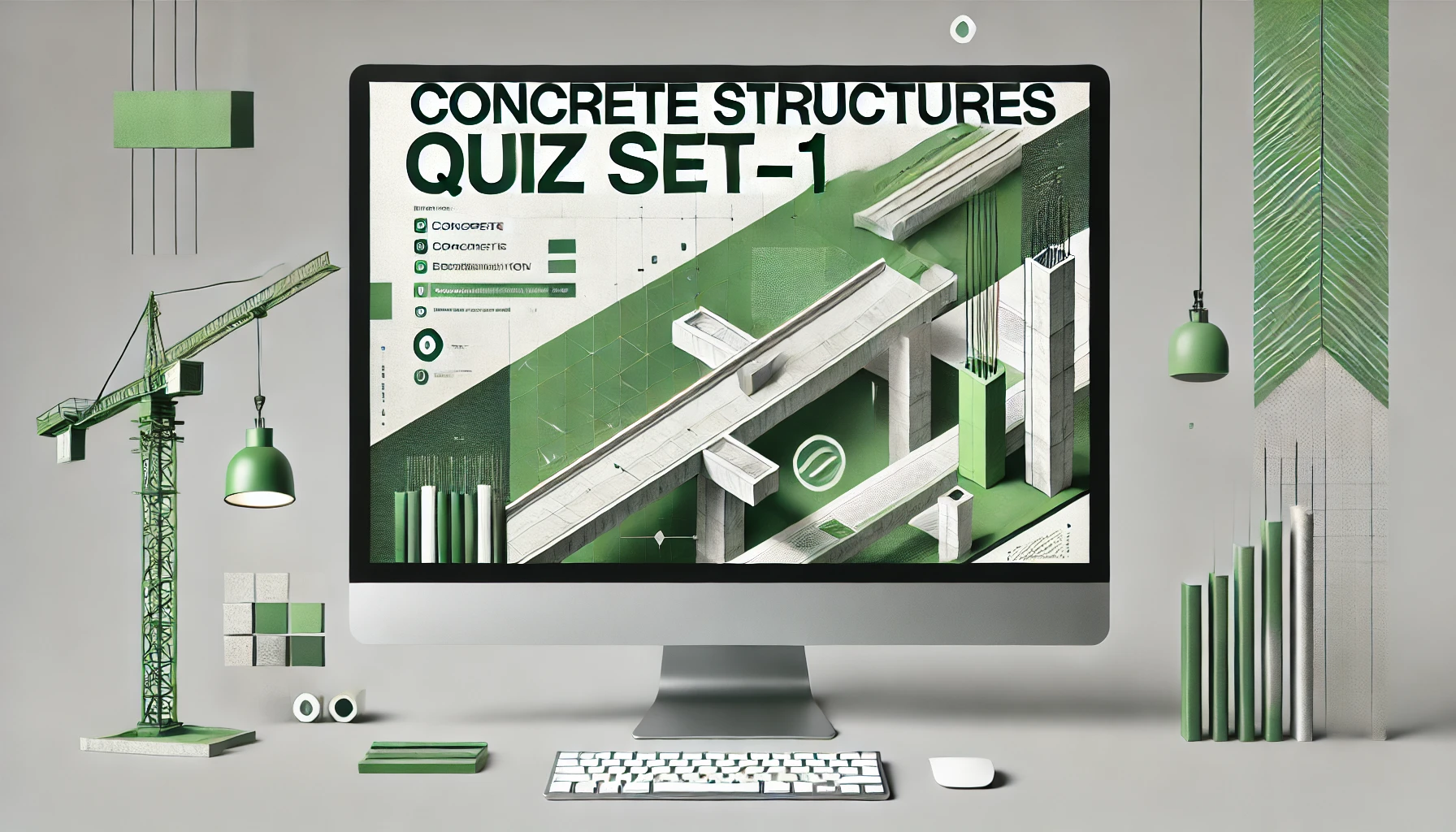Welcome to “Concrete Structures Quiz Set-1 [2025]”!
In this blog, we’ve curated 50+ thought-provoking multiple-choice questions covering the fundamental and advanced concepts of concrete structures. “Concrete Structures Quiz Set-1 [2025]” is designed to help you refresh your basics, challenge your knowledge, and gain practical insights into the design, analysis, and construction of concrete structures.
Whether you’re a civil engineering student, a construction professional, or preparing for competitive exams, this quiz is the perfect way to enhance your expertise in concrete structures.
Let’s dive into the “Concrete Structures Quiz Set-1 [2025]” and start exploring!
Concrete Structures: The Backbone of Modern Construction
Concrete structures form the foundation of modern infrastructure, playing a pivotal role in shaping the built environment. From towering skyscrapers and expansive bridges to resilient dams and robust residential buildings, concrete is a versatile and durable material that has revolutionized the construction industry. In this blog, we delve into the essentials of concrete structures, exploring their properties, types, design principles, and applications.
What Are Concrete Structures?
Concrete structures are constructions made primarily from concrete, a composite material consisting of cement, aggregates (sand, gravel, or crushed stone), and water. When mixed and cured, concrete hardens into a strong and durable material capable of withstanding various loads and environmental conditions.
The unique properties of concrete, such as its compressive strength, durability, and adaptability, make it a preferred choice for constructing a wide range of structures.
Properties of Concrete
- Compressive Strength:
- Concrete is exceptionally strong in compression, making it suitable for load-bearing applications.
- Durability:
- It resists weathering, chemical attacks, and abrasion, ensuring long service life.
- Workability:
- Fresh concrete can be molded into any shape, allowing for flexibility in design.
- Thermal Mass:
- Concrete can absorb and store heat, making it energy-efficient in temperature regulation.
- Low Tensile Strength:
- Concrete is weak in tension and often requires reinforcement with steel to improve its performance.
Types of Concrete Structures
- Reinforced Concrete Structures (RCC):
- Incorporates steel reinforcement bars to enhance tensile strength.
- Used in buildings, bridges, and foundations.
- Prestressed Concrete Structures:
- Utilizes pre-tensioned or post-tensioned steel to counteract tensile stresses.
- Common in long-span bridges and high-rise buildings.
- Plain Concrete Structures:
- Made without reinforcement, suitable for non-structural applications like pavements and sidewalks.
- Precast Concrete Structures:
- Components are cast and cured off-site, then assembled on-site.
- Used in modular construction and infrastructure projects.
- Lightweight Concrete Structures:
- Made with lightweight aggregates to reduce the overall weight of the structure.
- Ideal for high-rise buildings and seismic zones.
- High-Performance Concrete (HPC):
- Designed to meet specific performance requirements like high strength, durability, or resistance to aggressive environments.
Design Principles for Concrete Structures
- Load Analysis:
- Determine the types of loads (dead, live, wind, seismic) the structure will experience.
- Material Selection:
- Choose the appropriate grade of concrete and reinforcement based on design requirements.
- Structural Safety:
- Ensure stability, strength, and serviceability through proper design and analysis.
- Durability Considerations:
- Account for environmental factors like moisture, temperature changes, and chemical exposure.
- Reinforcement Detailing:
- Proper placement and anchoring of reinforcement to avoid structural failures.
- Adherence to Codes:
- Follow local and international building codes and standards (e.g., ACI, Eurocode, IS codes).
Applications of Concrete Structures
- Buildings:
- Used in residential, commercial, and industrial buildings for foundations, columns, beams, and slabs.
- Bridges:
- Provides strength and stability for long spans and heavy traffic loads.
- Dams and Reservoirs:
- Offers water resistance and durability under hydrostatic pressure.
- Roads and Pavements:
- Concrete is widely used in highways, runways, and urban pavements for its strength and longevity.
- Tunnels:
- Provides structural support and resistance to earth pressure.
- Marine Structures:
- Used in ports, docks, and offshore platforms due to its resistance to saltwater corrosion.
Advantages of Concrete Structures
- Versatility:
- Can be molded into any shape or size.
- Cost-Effective:
- Readily available materials and low maintenance requirements make it economical.
- Fire Resistance:
- Concrete does not burn, making it a fire-resistant material.
- Sustainability:
- Can incorporate recycled materials like fly ash and slag to reduce environmental impact.
- Longevity:
- Properly designed and maintained concrete structures can last for decades.
Challenges in Concrete Construction
- Cracking:
- Shrinkage, temperature changes, or improper curing can lead to cracks.
- Tensile Weakness:
- Requires reinforcement to handle tensile stresses.
- Environmental Impact:
- Cement production contributes to carbon emissions.
- Quality Control:
- Requires careful mixing, curing, and workmanship to ensure durability.
Modern Innovations in Concrete Structures
- Self-Healing Concrete:
- Contains bacteria or additives that repair cracks automatically.
- Ultra-High-Performance Concrete (UHPC):
- Offers exceptional strength and durability for specialized applications.
- 3D Printing:
- Enables rapid construction of complex concrete structures with minimal waste.
- Green Concrete:
- Incorporates sustainable materials to reduce the carbon footprint.
- Smart Concrete:
- Embedded sensors monitor structural health and performance.
